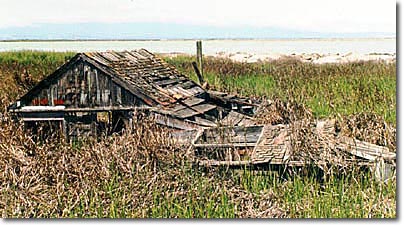This muddy little island in the South Bay would probably never have been noticed, let alone become a popular vacation spot, if two entrepreneurs, James Fair and Alfred Davis, had not come up with the idea of building a narrow-gauge railway all the way from Newark (and eventually Alameda) down to Santa Cruz, a total distance of 80 miles. Their South Pacific Coast Railroad (SPCRR) was built by Chinese laborers in the 1870’s and finished in 1880. It allowed people to get to Santa Cruz in four hours, rather than two days by stage-coach, and was therefore quite financially successful.
Milpitas People and Places
 Sunken House in Drawbridge, CA
Sunken House in Drawbridge, CASouth Pacific Coast Railroad Shortens Trip from Newark to Santa Cruz
The railroad path crossed two navigable waterways, Mud Creek Slough and Coyote Creek Slough, which were legally required to be kept open, so the SPCRR built drawbridges over them. They then built a small building, the first on the island (then called Station Island), to house a bridge-keeper, who opened the bridges when a steamboat or produce-laden scow schooner that needed to pass through blew its whistle.
Station Island Now Called Drawbridge Draws Summer Crowds
Starting with friends of the first bridge-keeper, George Mandersheit, people soon noticed that Station Island, now called Drawbridge, was an ideal spot for fishing and hunting, especially for ducks. By the turn of the century it sported lots of summer cabins and hunting (and drinking) clubs, and even hotels, mostly built on stilts because of the tides and wetland character of the island. Swimming and boating were also popular pastimes and hundreds of visitors would ride the train for a day or weekend jaunt to Drawbridge. The town developed a (perhaps exaggerated) reputation for partying and high times of all sorts.
Drawbridge Becomes a Ghost Town
But by the end of the 1920’s, the water quality was already discouraging for swimming. As time passed, the once-plentiful ducks, fish, mussels, and crabs were no longer around, and damage done by the salt ponds, pollution, and silt made the town no longer pleasant or even habitable. By 1955 the trains no longer stopped in Drawbridge, and the last resident moved out in 1976.
Because the agriculture of the past century used up so much of the underground water in the area, the land level has dropped considerably and the few picturesque buildings left in Drawbridge that were not vandalized or burned are now sinking into the marsh.
Public access to Drawbridge is now closed, but you can still walk through this strange and wonderful ghost town on tours offered through the Don Edwards San Francisco Bay National Wildlife Refuge. You can check schedules of the tours at this number: 408-262-5513.